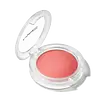What's inside
What's inside
 Key Ingredients
Key Ingredients

 Benefits
Benefits

 Concerns
Concerns

 Ingredients Side-by-side
Ingredients Side-by-side

Hydrogenated Polyisobutene
EmollientHydrogenated Poly(C6-14 Olefin)
EmollientMica
Cosmetic ColorantDiisostearyl Malate
EmollientOctyldodecanol
EmollientCalcium Titanium Borosilicate
AbrasiveTrimethylsiloxysilicate
EmollientIsododecane
EmollientHydrogenated Styrene/Isoprene Copolymer
Silica
AbrasiveSynthetic Fluorphlogopite
Disteardimonium Hectorite
StabilisingDextrin Palmitate
EmulsifyingSorbitan Sesquioleate
EmulsifyingPhenoxyethanol
PreservativePropylene Carbonate
SolventParfum
MaskingTin Oxide
AbrasiveTriethoxycaprylylsilane
Aluminum Hydroxide
EmollientPolyhydroxystearic Acid
EmulsifyingPentaerythrityl Tetra-Di-T-Butyl Hydroxyhydrocinnamate
AntioxidantTocopherol
AntioxidantTitanium Dioxide
Cosmetic ColorantCI 15985
Cosmetic ColorantIron Oxides
CI 15850
Cosmetic ColorantHydrogenated Polyisobutene, Hydrogenated Poly(C6-14 Olefin), Mica, Diisostearyl Malate, Octyldodecanol, Calcium Titanium Borosilicate, Trimethylsiloxysilicate, Isododecane, Hydrogenated Styrene/Isoprene Copolymer, Silica, Synthetic Fluorphlogopite, Disteardimonium Hectorite, Dextrin Palmitate, Sorbitan Sesquioleate, Phenoxyethanol, Propylene Carbonate, Parfum, Tin Oxide, Triethoxycaprylylsilane, Aluminum Hydroxide, Polyhydroxystearic Acid, Pentaerythrityl Tetra-Di-T-Butyl Hydroxyhydrocinnamate, Tocopherol, Titanium Dioxide, CI 15985, Iron Oxides, CI 15850
Dimethicone
EmollientDiisostearyl Malate
EmollientHydrogenated Poly(C6-14 Olefin)
EmollientOctyldodecanol
EmollientSilica
AbrasiveDimethicone/Vinyl Dimethicone Crosspolymer
Skin ConditioningHexyl Laurate
EmollientVitis Vinifera Seed Oil
EmollientSimmondsia Chinensis Seed Oil
EmollientCaprylyl Glycol
EmollientDisteardimonium Hectorite
StabilisingPropylene Carbonate
SolventTriethoxycaprylylsilane
Tocopheryl Acetate
AntioxidantPhenoxyethanol
PreservativeSorbic Acid
PreservativeMica
Cosmetic ColorantCI 77891
Cosmetic ColorantCI 77491
Cosmetic ColorantCI 77492
Cosmetic ColorantCI 77499
Cosmetic ColorantCI 77163
Cosmetic ColorantCI 75470
Cosmetic ColorantCI 77289
Cosmetic ColorantCI 77288
Cosmetic ColorantCI 77510
Cosmetic ColorantCI 77742
Cosmetic ColorantCI 15850
Cosmetic ColorantCI 73360
Cosmetic ColorantCI 42090
Cosmetic ColorantCI 45410
Cosmetic ColorantCI 19140
Cosmetic ColorantCI 15985
Cosmetic ColorantDimethicone, Diisostearyl Malate, Hydrogenated Poly(C6-14 Olefin), Octyldodecanol, Silica, Dimethicone/Vinyl Dimethicone Crosspolymer, Hexyl Laurate, Vitis Vinifera Seed Oil, Simmondsia Chinensis Seed Oil, Caprylyl Glycol, Disteardimonium Hectorite, Propylene Carbonate, Triethoxycaprylylsilane, Tocopheryl Acetate, Phenoxyethanol, Sorbic Acid, Mica, CI 77891, CI 77491, CI 77492, CI 77499, CI 77163, CI 75470, CI 77289, CI 77288, CI 77510, CI 77742, CI 15850, CI 73360, CI 42090, CI 45410, CI 19140, CI 15985
 Reviews
Reviews

Ingredients Explained
These ingredients are found in both products.
Ingredients higher up in an ingredient list are typically present in a larger amount.
Ci 15850 is the pigment color red. It is an azo dye and created synthetically.
Azo dyes need to be thoroughly purified before use. This allows them to be more stable and longer-lasting.
This ingredient is common in foundations, lipsticks, and blushes. This color is described as brown/orangey red.
It has many secondary names such as Red 6 and Red 7. According to a manufacturer, Red 6 usually contains aluminum.
Learn more about CI 15850Ci 15985 is a dye made from petroleum. It is synthetically created and approved by the FDA for use in foods and cosmetics.
The color of this dye is orange/yellow.
This ingredient can be found in makeup, sun care, and skincare.
Learn more about CI 15985Diisostearyl Malate is an emollient and most often used in lip products. It comes from isostearyl alcohol, a fatty acid, and malic acid, an AHA.
As an emollient, Diisostearyl Malate helps create a thin film on your skin to trap moisture in. This helps keep your skin soft and smooth.
Disteardimonium Hectorite comes from the clay mineral named hectorite. It is used to add thickness to a product.
It can also help stabilize a product by helping to disperse other ingredients.
Hectorite is a rare, white clay mineral.
Learn more about Disteardimonium HectoriteWe don't have a description for Hydrogenated Poly(C6-14 Olefin) yet.
Mica is a naturally occurring mineral used to add shimmer and color in cosmetics. It can also help improve the texture of a product or give it an opaque, white/silver color.
Serecite is the name for very fine but ragged grains of mica.
This ingredient is often coated with metal oxides like titanium dioxide. Trace amounts of heavy metals may be found in mica, but these metals are not harmful in our personal products.
Mica has been used since prehistoric times throughout the world. Ancient Egyptian, Indian, Greek, Roman, Aztec, and Chinese civilizations have used mica.
Learn more about MicaOctyldodecanol is a fatty alcohol. It is primarily used to enhance the texture of products.
As an emulsifier, Octyldodecanol helps prevent the oils and waters from separating. It also prevents ingredients from creating foam when shaken.
Octyldodecanol is created by reducing fatty acid to an alcohol.
Due to its high molecular weight, it does not get absorbed into the skin.
Learn more about OctyldodecanolPhenoxyethanol is a preservative that has germicide, antimicrobial, and aromatic properties. Studies show that phenoxyethanol can prevent microbial growth. By itself, it has a scent that is similar to that of a rose.
It's often used in formulations along with Caprylyl Glycol to preserve the shelf life of products.
This ingredient is a solvent. It helps dissolve active ingredients and alter the texture of products.
Propylene Carbonate is commonly used in makeup and with clay, such as montmorillonite or bentonite.
Studies show this ingredient to be safe for cosmetics. When it is undiluted, it can cause skin irritation. (It is always diluted in skincare and makeup). This ingredient is water-soluble.
Propylene Carbonate is created from propylene glycol and carbonic acid.
Learn more about Propylene CarbonateSilica, also known as silicon dioxide, is a naturally occurring mineral. It is used as a fine, spherical, and porous powder in cosmetics.
Though it has exfoliant properties, the function of silica varies depending on the product.
The unique structure of silica enhances the spreadability and adds smoothness, making it a great texture enhancer.
It is also used as an active carrier, emulsifier, and mattifier due to its ability to absorb excess oil.
In some products, tiny microneedles called spicules are made from silica or hydrolyzed sponge. When you rub them in, they lightly polish away dead skin layers and enhance the penetration of active ingredients.
Learn more about SilicaTriethoxycaprylylsilane is a silicone used to bind and stabilize ingredients.
As an emulsifier, it helps prevent ingredients from separating. This can help elongate the shelf life of products.
Triethoxycaprylylsilane is often used to coat mineral sunscreens ingredients to help give a better feel. It also helps reduce oxidative stress in sunscreens.
Learn more about Triethoxycaprylylsilane